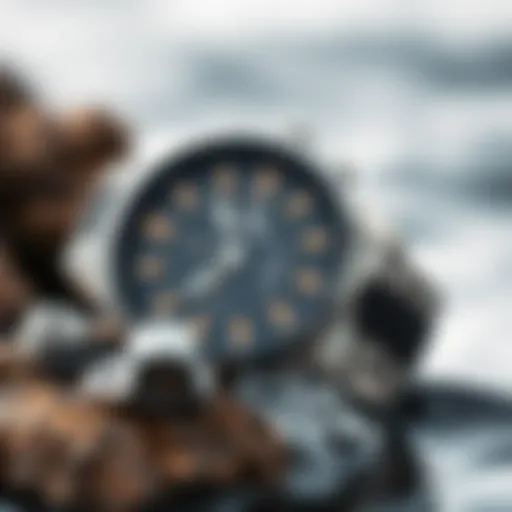Essential Insights into Kitesurfing Harness Sales Trends
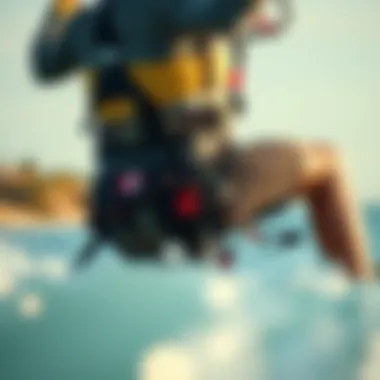
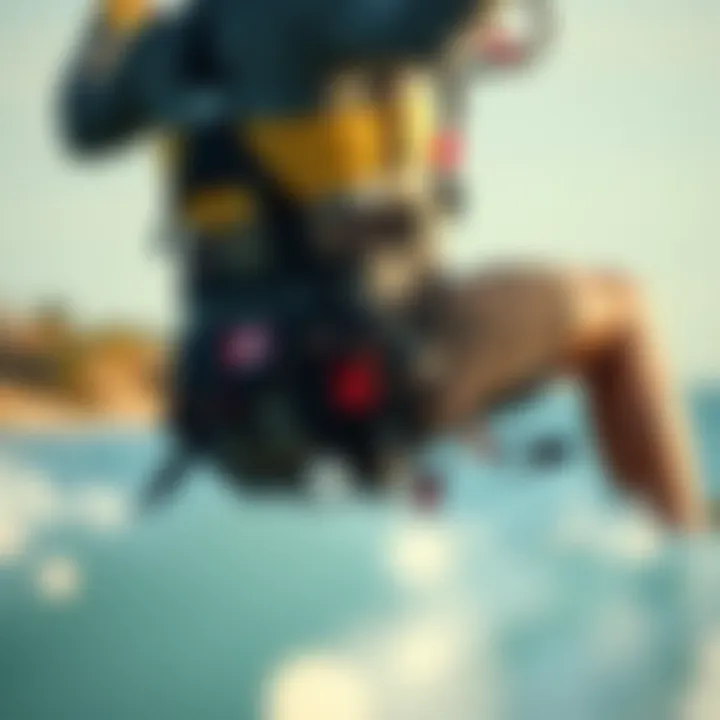
Intro
Kitesurfing is an exhilarating sport that combines elements of surfing, windsurfing, and paragliding. The right equipment can make all the difference, especially when it comes to harnesses. A harness is not just a simple accessory; it is a fundamental component that directly influences your control and comfort while riding the waves. In the ever-evolving world of kitesurfing, understanding the nuances of different harnesses, their sales trends, and what to look for when purchasing one is essential for both newcomers and seasoned pros alike.
This article aims to shed light on the kitesurfing harness market, diving deep into trends and technological advancements, as well as providing practical buying tips. Whether you're just starting out or looking to upgrade to something more advanced, the insights within these paragraphs will help guide your choices.
Navigating the sea of options can be overwhelming, but with informed decisions, your time spent on the waters will be rewarding and enjoyable. Get ready to explore various harness types, trends that shape the industry, and the essential factors to consider when shopping. Let's unfurl the sails and get started!
Expert Insights
Latest Trends in Watersports
The kitesurfing harness market is continually changing, reflecting broader trends in water sports. In recent times, there has been an increasing emphasis on eco-friendly materials and manufacturing processes. Brands are taking steps to reduce their carbon footprints and produce harnesses that are not only durable but also sustainable. This shift is appealing to environmentally-conscious kitesurfers who want to enjoy their favorite sport while minimizing their impact on the environment.
Furthermore, technological advancements have led to harnesses that incorporate smart textiles, which can enhance performance through improved comfort and fit. Some manufacturers are experimenting with lightweight materials that maintain strength while providing superior flexibility. This is crucial for performance, as it lets riders maneuver more freely and respond effectively to changing conditions.
"Innovation in harness design can significantly elevate the kitesurfing experience, allowing for greater enjoyment on the water."
Safety Protocols and Best Practices
As kitesurfing gains popularity, the conversation around safety is more important than ever. It’s crucial for both new and experienced surfers to stay informed about best practices to ensure they’re safe on the water. One major point is understanding how to properly adjust and fit your harness; a well-fitted harness can reduce the risk of injury and improve performance.
Here are some key safety practices:
- Always wear a helmet: Even experienced riders can fall, and a helmet can protect against potential head injuries.
- Check your equipment regularly: Just like a car needs maintenance, a kitesurfing setup does too. Make sure your harness and lines are in good condition before hitting the waves.
- Understand the weather: Knowledge of wind conditions is vital. Ideally, one should only kitesurf in conditions that match their skill level.
- Learn self-rescue techniques: Everyone should be equipped with the know-how to handle situations where they might be in trouble.
By implementing these safety protocols, kitesurfers can enjoy their experiences without unnecessary risk while gripping the thrill of riding the waves.
Understanding Kitesurfing Harnesses
Kitesurfing harnesses play a crucial role in the overall kitesurfing experience. For both beginners and seasoned pros, understanding what a harness is and its significance is more than just a fashion statement; it’s about safety and performance on the water. If you're serious about kitesurfing, knowing the ins and outs of harnesses will help you choose wisely, ensuring a more enjoyable ride and potentially keeping you out of harm's way.
What is a Kitesurfing Harness?
A kitesurfing harness is a piece of equipment worn around the waist or hips, designed to connect you to the kite’s lines through a hook and loop system. Think of it as a bridge between the kite and the rider. This essential gear supports your body while kiteboarding, distributing the pull of the kite across your torso instead of just your arms. By allowing your body to harness the power of the wind, it enables you to ride more effectively and for longer periods.
Kitesurfing harnesses come in various styles, including seat harnesses and waist harnesses, each catering to different riding styles and preferences. For instance, a seat harness fits snugly around the hips and might work better for those just getting their feet wet, while a waist harness allows for more mobility and is often favored by experienced athletes who perform aerial tricks.
Why a Harness is Essential for Kitesurfing
The importance of a harness extends beyond mere comfort; it directly impacts safety and performance. Here are several key reasons why having a quality harness is essential for anyone looking to enjoy kitesurfing:
- Safety: A proper harness keeps you securely attached to the kite, helping to prevent accidents or falls that could lead to injuries.
- Control: A well-fitted harness provides the necessary support, allowing better control of the kite while riding. This improves your ability to maneuver and adjust to changing wind conditions.
- Endurance: By distributing strain across your body, a harness allows you to kite longer without tiring your arms excessively, thus enhancing your overall experience.
- Performance: Having the right harness can elevate your performance. It allows you to perform jumps and tricks more efficiently, maximizing the power of the kite.
“The right harness is like a set of wings; it gives you the freedom to soar.”
Investing time in understanding kitesurfing harnesses is not just about purchasing gear; it's about enhancing your overall kitesurfing journey. Knowing what to look for can save you not only money in the long run but also plenty of frustration out on the water.
Types of Kitesurfing Harnesses
When diving headfirst into the world of kitesurfing, understanding the different types of harnesses often acts like a North Star, guiding enthusiasts to make informed choices. These harnesses come in various styles, each designed with unique features tailored to accommodate individual preferences and riding styles. It's crucial for both beginners and seasoned riders to familiarize themselves with these options, as they can significantly influence performance and comfort on the water.
Seat Harnesses
Seat harnesses are designed to offer maximum support and stability, making them an excellent choice for those new to kitesurfing. They fit snugly around the hips and lower back, distributing the pull from the kite evenly across the body. This design is particularly beneficial when riding in high winds, as it helps in maintaining control while also alleviating pressure on the lower back.
The advantages of seat harnesses include:
- Enhanced Control: The snug fit around the hips provides superior stability, allowing for better management of kite power.
- Comfort: With added padding, these harnesses tend to be quite comfortable, making them suitable for extended sessions on the water.
- Compatibility with Safety Gear: Many seat harnesses come equipped with features that easily accommodate safety equipment, ensuring that riders can focus on their performance without compromising safety.


However, it’s essential to note that some riders find seat harnesses can restrict mobility a bit more compared to other types. They might feel a bit bulkier for aggressive maneuvers or tricks. For those who plan to stay within the realm of casual riding, the benefits generally outweigh the drawbacks.
Waist Harnesses
On the other hand, waist harnesses are favored for their versatility and increased freedom of movement. With a design that rests at the waist, they offer a more streamlined profile that many riders appreciate, particularly those who are into performing jumps or tricks. Because the harness sits higher on the body, it allows for a broader range of motion in the hips and legs.
Some benefits of waist harnesses include:
- Mobility: The higher placement on the torso gives kitesurfers more freedom to twist and turn without feeling confined.
- Lightweight Design: Typically made with lighter materials, these harnesses can feel less cumbersome during intense sessions.
- Adaptability: Many waist harnesses can be easily adjusted or replaced with various spreader bars that cater to specific styles and preferences.
Yet, it’s worth mentioning that waist harnesses may not provide the same level of support as seat harnesses. As a rider becomes more advanced, they might find that comfort during technical maneuvers becomes a primary concern. Regardless, waist harnesses remain a popular choice among both new and experienced kitesurfers.
Combination Harnesses
Finally, combination harnesses attempt to blend the best traits of both seat and waist harnesses into a single product. Often equipped with adjustable straps, riders can customize how they wear the harness, depending on their preferences and the types of conditions they encounter.
Key features of combination harnesses include:
- Dual Functionality: They provide both low and high harnessing options, adjusting as necessary to suit various riding styles.
- Custom Adjustability: These harnesses allow users to find the perfect fit, providing comfort and support tailored to individual needs and building techniques.
- Versatile Use: Great for different aspects of wind-related sports such as kitesurfing and wakeboarding, making them a smart investment for multi-sport enthusiasts.
While combination harnesses might not be the first choice for all enthusiasts, they do offer flexibility that can be appealing, especially in varying conditions. It’s a compelling option for those who want to dip their toes into different riding styles without committing to a specific type in the beginning.
In the end, the type of harness you choose will largely depend on your riding style, level of experience, and personal comfort preferences. As kitesurfing continues to evolve, these harness types adapt alongside it, ensuring there’s always a perfect fit for every rider.
Factors Influencing Harness Purchase Decisions
When it comes to choosing a kitesurfing harness, several key factors sway a buyer’s decision. It's not just about the price tag or the brand reputation, even though those aspects play a role. Instead, the overall experience of kitesurfing can hinge on the quality and suitability of the harness for an individual’s needs. Here, I'll dive into the specific elements that can shape your purchasing choice.
Material and Durability
When selecting a harness, the material it’s made from is a crucial component. Harnesses are typically constructed from a blend of nylon, neoprene, and sometimes features reinforced stitching. Each of these materials plays a part in how well the harness holds up against the rigors of the water environment.
- Nylon is often chosen for its lightweight nature but may not always offer the ruggedness needed for extreme conditions.
- Neoprene adds comfort and flexibility, enabling better movement during tricks or in rough waters.
- Reinforced stitching can significantly enhance durability, particularly in high-stress areas. It’s worth checking user feedback because real-world experience often reveals how different harness materials perform over time.
Buying decision should factor in where you plan to kite—coastal waters with sharper obstacles demand sturdier materials.
Comfort and Fit
A harness may boast high-tech features, but if it doesn’t fit right or isn’t comfortable, it’s as good as a lead anchor. Comfort translates to performance on the water; a snug fit can minimize fatigue while kitesurfing. Each type of harness (seat, waist, combination) fits differently, and individual body types play a big part in finding the right match.
- Always try a harness on before committing. If a local shop lets you put it on, take a few minutes to mimic kitesurfing movements.
- Check for padding and adjustability; not everyone has the same torso length or body shape. You want something that hugs you but doesn’t constrict movement.
- Look for features like lumbar support or quick-release mechanisms, which can also enhance comfort during extended sessions.
Safety Features
Safety isn’t optional when it comes to watersports. A well-designed harness should include safety features that protect while still allowing for freedom of movement. For instance, harnesses often have a safety hook that allows for a quick release when necessary. In situations where you might get tossed around, knowing that your harness can quickly detach is vital.
Some harnesses even come with built-in floatation. While it’s not a substitute for a life jacket, it can provide an extra layer of security should you find yourself in unexpectedly choppy waters.
"Investing in a harness that incorporates solid safety features is as important as your other gear. Don’t leave it to chance."
Brand Reputation
Brand reputation plays its part in the decision-making process but should not overshadow the other factors I discussed. Kitsurfing harnesses from established brands often come with the benefit of tried-and-true designs and positive customer feedback. Look for companies that specialize in watersports and have a solid history in producing harnesses.
- Research customer reviews from reputable sources, as they frequently highlight durability and comfort issues that might not be immediately apparent in store.
- When considering a brand, it’s also wise to see if they offer warranties or guarantees, which can be an indicator of the manufacturer’s confidence in their product.
While brand loyalty can be a draw, balancing it with a harness tailored to your personal needs will yield the best results.
Where to Buy Kitesurfing Harnesses
In the ever-evolving world of kitesurfing, finding the right harness is just as crucial as selecting the perfect kite. The place you choose to purchase your harness has its significance. With various options available to enthusiasts, navigating the buying landscape requires an understanding of where to look. This section dives into the value of seeking out reliable sources for kitesurfing harnesses, which can mean the difference between a seamless ride and an uncomfortable experience on the water.
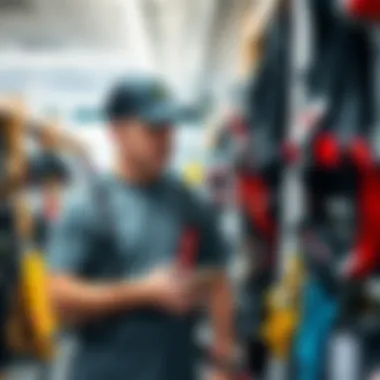

Retail Sports Stores
Retail sports stores offer a tangible shopping experience that's hard to beat. Imagine walking into a shop, feeling the materials of different harnesses, and asking questions directly to sales staff who might also be kitesurfing enthusiasts themselves. This firsthand interaction allows for greater insight into the product and provides an opportunity to gauge fit before making a purchase.
The bustling atmosphere of a sports store often features a variety of brands, enabling you to compare options side by side. You can also check out seasonal sales, which can result in significant savings. It’s also common for stores to have closeout sections where last season’s models are offered at reduced prices. However, be prepared: not every store specializes specifically in kitesurfing gear, which could limit your choices.
Online Marketplaces
The rise of online shopping has transformed how consumers purchase kitesurfing harnesses. Websites such as Amazon and eBay provide the convenience of browsing extensive inventories from the comfort of home. The ability to read product descriptions and compare prices at a glance is a considerable benefit.
In addition to convenience, online marketplaces often have customer reviews available, offering insights into how a harness performed in real-world conditions. Be cautious, though; with plenty of options can come overwhelming choices. Filtering through numerous listings to find reputable sellers with positive feedback is essential. Often, you'll come across both brand new items and pre-owned deals, offering a range of prices for every budget.
Even with the convenience of online shopping, it’s wise to consider shipping times and return policies. Unforeseen snags can happen, from damages during shipping to simply changing one's mind about fit. Ensuring a hassle-free return process can save future headaches.
Specialty Kitesurfing Shops
If you’re looking for something more tailored to your needs than what mainstream options provide, specialty kitesurfing shops are the goldmine. These stores focus specifically on water sports gear and typically carry a range of harnesses designed for different riding styles and skill levels.
Visiting such shops often means interacting with staff who possess deeper knowledge about kitesurfing equipment. They can offer personalized recommendations based on your skill level, preferences, and riding conditions. Many specialty shops also host events or community gatherings, creating an environment that fosters passion for the sport.
While the prices might be slightly higher than those at general retailers, the craft and care evident in these products could justify the investment. Special sales might also occur frequently, especially during transitioning seasons or just before buoyant weather months. Plus, purchasing locally supports your community, which can be a rewarding decision.
Purchasing a kitesurfing harness is a balance of personal preference, comfort, and budget. The quality of the harness influences your overall surfing experience. Thus, exploring these purchasing avenues can lead to a well-informed decision and, ultimately, a rewarding kitesurfing adventure.
Evaluating Kitesurfing Harness Sales
When considering the world of kitesurfing harnesses, one aspect that shouldn't be overlooked is the evaluating of harness sales. This is crucial for kitesurfing enthusiasts wanting to find the best options that fit their needs and budgets. Understanding how to assess these sales helps refine choices, ensuring a safe and enjoyable kitesurfing experience. Not all sales are created equal, and many external factors play into the worth of a harness and its sale price.
Analyzing Price Trends
Navigating the intricacies of kitesurfing harness prices requires a keen eye for trends. Prices can fluctuate due to various factors: demand, seasonal changes, and even economic conditions. For instance, when spring rolls around, many retailers tend to stock up on gear, leading to competitive pricing and occasional markdowns. Keeping tabs on these shifts can save you a pretty penny.
Being attuned to price trends not only enhances your ability to gauge a good deal but also aids in recognizing patterns over time. You might find that certain brands consistently hold their value, while others see sharp declines after peak seasons. Watching platforms such as Reddit or specialized forums can provide insight and anecdotal evidence from fellow riders.
Seasonal Sales Events
Kitesurfing enthusiasts know that timing can make all the difference when shopping for harnesses. Many stores and online marketplaces hold seasonal sales events that coincide with outdoor sports seasons. For example, Black Friday, Cyber Monday, or end-of-summer clearance sales often yield exciting discounts.
During these occasions, it's not uncommon to find harnesses from esteemed brands like Ocean Rodeo and North Kiteboarding being offered at reduced prices. Keeping an eye out for these events and planning your purchases around them can make your wallet happy, allowing you to invest in quality gear without breaking the bank. Moreover, it pays to subscribe to newsletters or follow brands on social media; you may just score insider information on upcoming deals.
Promotions and Discounts
There’s nothing quite like snagging a good promotion when you’re shopping for kitesurfing gear. Various brands frequently offer limited-time discounts, bundle deals, or loyalty rewards. Discounts can range from 10% to an eye-popping 50%, making it pivotal to remain vigilant. Checking websites consistently, or even using price comparison tools, could arm you with the information you need to avoid overpaying.
Many retailers also offer promotions in partnership with local kitesurfing events or competitions, providing discounts to attendees or participants. This not only encourages community engagement but also promotes new riders to invest in their first harness. So, don’t hesitate to tap into these networks; you might be pleasantly surprised!
Always remember: keeping an organized list of what you're looking for might help streamline your shopping experience. Real-time comparisons can clarify where best to buy your gear based on ongoing promotions.
By considering these aspects, you’ll find you can navigate the market in a much more informed way. Understanding price trends, recognizing seasonal sales, and actively searching for promotions empowers you to make meaningful purchasing decisions that reflect both careful consideration and savings.
Making an Informed Purchase
When it comes to kitesurfing, the right harness can make or break your experience. The decision-making process surrounding a harness purchase is not something to take lightly. You’re not just looking for a snug fit; you’re hunting for a blend of function, durability, and comfort. The stakes are high, and understanding how to navigate this maze is crucial.
Researching and Comparing Products
In the vast market of kitesurfing harnesses, your first step should be to research thoroughly. From the start, delve into different styles—like seat or waist harnesses—and understand their unique advantages. Each type is designed with specific user needs in mind. For instance, seat harnesses generally offer more support for larger jumps, while waist harnesses allow for more mobility.
Once you have a basic grasp, it’s time to compare products. Utilize online resources and local shops to stack different options side-by-side. Look at brand reputation, price points, and user feedback. A side-by-side comparison can highlight key differences, revealing features that might sway your decision. Websites often offer product comparison tools that can simplify this process.
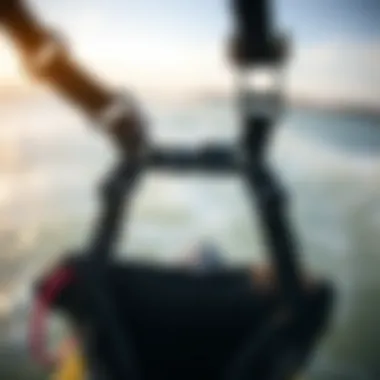
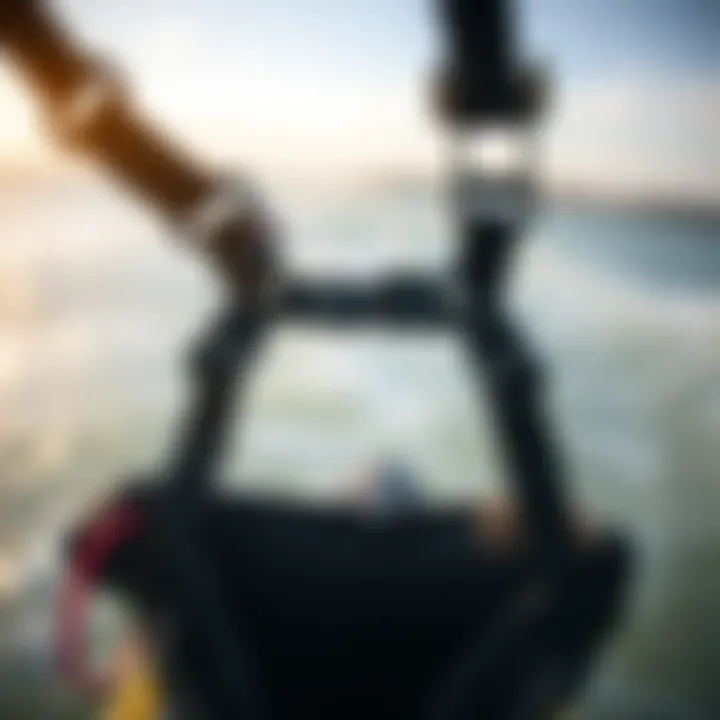
Reading Customer Reviews
Reviews from fellow kitesurfers can be goldmines of honest feedback. They reveal the actual performance of a harness, which glossy marketing material can't always capture. Whether it’s comfort during long sessions or the practicality of design under various weather conditions, real user experiences provide invaluable insights.
When sifting through reviews, pay attention to details like:
- Durability: How does it hold up over time?
- Comfort: Does it fit well and feel good during rides?
- Functionality: Does it meet the rider's needs effectively?
Be sceptical of overly enthusiastic or negative reviews; it helps to focus on trends across multiple reviews to get a balanced picture.
Consulting with Experts
Sometimes, two (or more) heads are better than one. Don't shy away from consulting experts or seasoned kitesurfers. Many times, kitesurfing shops have staff that are not only knowledgeable but also passionate about the sport. They can guide you toward a harness that suits your skill level and riding style.
Online forums, like those found on websites such as Reddit or dedicated kitesurfing platforms, can also serve as excellent venues for advice. Engaging in discussions may show you options you hadn’t previously considered.
Additionally, attending local kitesurfing events or meet-ups can expose you to the harnesses that other athletes swear by. Being able to physically try on options can also clarify your choice, making the decision process feel more secure.
"What fits one kitesurfer perfectly might not sit well with another" - always remember each individual has unique preferences.
The essence of making an informed purchase lies in thorough research, engaging with the community, and being meticulous about what you need versus what’s available. Investing time in this vital phase not only ensures you get a quality harness but also elevates your kitesurfing experience overall.
Harness Maintenance and Care
Maintaining a kitesurfing harness is not just about keeping it clean; it’s about ensuring your safety and enhancing your performance on the water. A well-maintained harness can not only withstand the rigors of kitesurfing but can also make your experience smoother and more enjoyable. Neglecting the care of this crucial piece of equipment can lead to tears, fraying, and other failures that may compromise not just your equipment but also your safety.
Here’s a closer look at the essential elements that encapsulate proper harness maintenance and care, as well as the benefits it brings to your kitesurfing journey.
Regular Inspections
When it comes to kitesurfing harnesses, an ounce of prevention is worth a pound of cure. Regular inspections are vital as they help catch any potential issues before they escalate into significant problems. During your inspection, pay attention to the following:
- Webbing and Stitching: Look for any fraying or signs of wear in the straps. Strength is key, and if you see threads hanging on, it’s time to consider a replacement.
- Buckles and Clips: Ensure all hardware is functioning correctly. Pieces that are rusty or don’t engage seamlessly should be addressed, as you need to trust your safety mechanisms completely.
- Padding Condition: The padding in your harness should be intact and free from rips. Worn padding doesn’t just make for an uncomfortable ride; it can also lead to injuries.
Don’t just do a lackadaisical glance over your gear—get in there and give it a thorough once-over after every few sessions. This habit will serve you well in the long run.
Cleaning and Storage Tips
- Rinse After Use: After kitesurfing, rinse your harness with fresh water. Salt and sand can cause significant damage over time, so a quick rinse is crucial.
- Air Dry: Hang your harness up to dry after rinsing. Avoid direct sunlight as it can degrade the materials over time, but ensure it dries completely to prevent mold or odors.
- Storage Location: Keep your harness in a cool, dry place. A damp or exceedingly hot environment can cause wear and tear faster than you think.
Storing your harness properly is just as essential as washing it. Make sure it’s not crammed in a tight spot where it can get squished or damaged. A dedicated bag for your harness can go a long way in maintaining its shape and integrity.
"Proper care of your kitesurfing harness not only extends its lifespan but also significantly enhances your safety and performance while riding the waves."
Keeping yourself safe and your gear in top condition will allow for an enjoyable kitesurfing experience each time you hit the water. Take every step seriously because the consequences of neglecting harness maintenance can be severe.
Future Trends in Kitesurfing Harnesses
The world of kitesurfing harnesses is not static; it's evolving rapidly. As the sport gains popularity, so does the technology that surrounds it. Understanding the future trends in kitesurfing harnesses is essential for athletes, coaches, and recreational enthusiasts alike. These trends not only shape the equipment available on the market but also influence how kitesurfers approach their sport. This section examines critical elements influencing these trends, highlighting the benefits and considerations that should be on every kitesurfer's radar.
Technological Innovations
In the kitesurfing realm, technological advancement can be a game-changer. New materials, designs, and features are developed, establishing the bar for performance and safety. Here are some key innovations making waves in harness technology:
- Smart Harnesses: Emerging in kiting fleets, smart harnesses equipped with sensors monitor the rider's movement and provide data on performance metrics. This could help athletes to fine-tune their techniques and track improvements over time.
- Lightweight Materials: Advances in materials such as carbon fibers and advanced composites lead to lighter, yet durable harnesses. A lighter harness translates into more agility on the water, allowing for a seamless experience.
- Ergonomic Design: Innovations in the ergonomic design of the harness improve fit and comfort. Many manufacturers are placing a strong emphasis on customizable features that cater to different body shapes and preferences.
These features not only enhance usability but also promote a more enjoyable and effective kitesurfing experience. Keeping an eye on these advancements can provide potential buyers with a distinct edge.
Sustainability in Manufacturing
As environmental consciousness rises globally, so too does the push for sustainable practices across industries, including kitesurfing. Harness manufacturers are beginning to embrace sustainability in manufacturing processes, marking a significant shift in purchasing priorities. Some noteworthy points include:
- Eco-Friendly Materials: More companies are opting for recycled or bio-based materials for harness construction. This reduces the environmental impact and appeals to eco-conscious consumers.
- Responsible Production: Companies that prioritize fair labor practices and environmentally friendly production methods are becoming more prominent. Consumers are increasingly drawn to brands that align with their values, challenging manufacturers to adopt responsible practices.
- End-of-Life Consideration: Some brands are introducing take-back programs where used harnesses can be returned for recycling or repurposing. This concept is steadily gaining acceptance, promoting a circular economy within the kitesurfing community.
These sustainability initiatives not only help the environment but also resonate with a growing demographic that values ethical consumption.
In summary, the future of kitesurfing harnesses hinges on technological innovation and sustainability practices. Embracing these trends can lead to improved performance on the water while contributing to a cleaner planet. Outfitting oneself with gear that embodies these values not only enhances the kitesurfing experience but also champions the industry's growth toward a responsible future.





